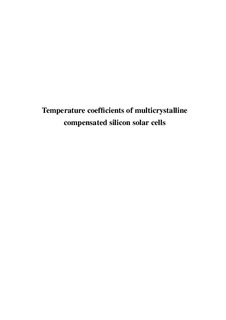| dc.contributor.author | Berthod, Charly | |
| dc.date.accessioned | 2017-01-02T07:46:11Z | |
| dc.date.available | 2017-01-02T07:46:11Z | |
| dc.date.issued | 2016 | |
| dc.identifier.uri | http://hdl.handle.net/11250/2425930 | |
| dc.description | Doktorgradsavhandling ved Fakultet for teknologi og realfag, Universitetet i Agder, 2016 | nb_NO |
| dc.description.abstract | This thesis focuses on the bulk properties influencing the temperature coefficients of solar cells. The conversion efficiency of PV devices degrades with increasing temperature. The temperature coefficient of the open-circuit voltage can be improved by increasing the open-circuit voltage. Therefore with the continuous improvement of the conversion efficiencies over the last decades due to the global R and D efforts, the temperature sensitivity was continuously reduced. The major research question of this thesis is: are there other ways to improve the temperature sensitivity? It had been shown prior to the present work, that solar cells made of silicon processed by upgraded metallurgical routes had beneficial temperature coefficients compared to cells made of polysilicon. This effect was studied in this work, and it is shown that no significant difference is observed between cells with distinct compensation levels. This was made on a relatively small compensation level range. Another influencing parameter on the temperature coefficients is the height at which the wafer was picked in the ingot to be processed into a solar cell. The best temperature coefficients are most likely to be found at the top of the ingot. Yet the cell structure can change this result because of a larger variations of the cell parameters along the ingot height. It is known that reducing the bulk resistivity can improve the temperature coefficients. In the present work, the role of reducing bulk resistivity is examined with a focus on the impact on each cell parameter. It is shown that using a cell structure with a lower series resistance for a given bulk resistivity, is beneficial for the temperature coefficient of the fill factor. Light-induced degradation has a negative effect on the cell parameters, especially the open-circuit voltage. This degrades the temperature coefficients. Additionally the dependence of the temperature coefficients with irradiance was investigated. It is shown that the temperature sensitivity is intensified at low irradiance due to the decrease of the open-circuit voltage. In conclusion, it is shown that temperature sensitivity of solar cells can be controlled by adjusting various bulk parameters. The solidification step has a big impact on the temperature coefficients due to the cell parameters variations and the changes in recombination mechanisms. Moreover light-induced degradation deteriorates the temperature sensitivity. | nb_NO |
| dc.language.iso | eng | nb_NO |
| dc.publisher | Universitet i Agder / University of Agder | nb_NO |
| dc.relation.ispartofseries | Doctoral dissertations at University of Agder; | |
| dc.rights | Navngivelse-Ikkekommersiell-DelPåSammeVilkår 4.0 Internasjonal | * |
| dc.rights.uri | http://creativecommons.org/licenses/by-nc-sa/4.0/deed.no | * |
| dc.title | Temperature coefficients of multicrystalline compensated silicon solar cells | nb_NO |
| dc.type | Doctoral thesis | nb_NO |
| dc.subject.nsi | VDP::Teknologi: 500 | nb_NO |
| dc.source.pagenumber | XIV, 106 s, | nb_NO |
| dc.source.issue | 148 | nb_NO |

